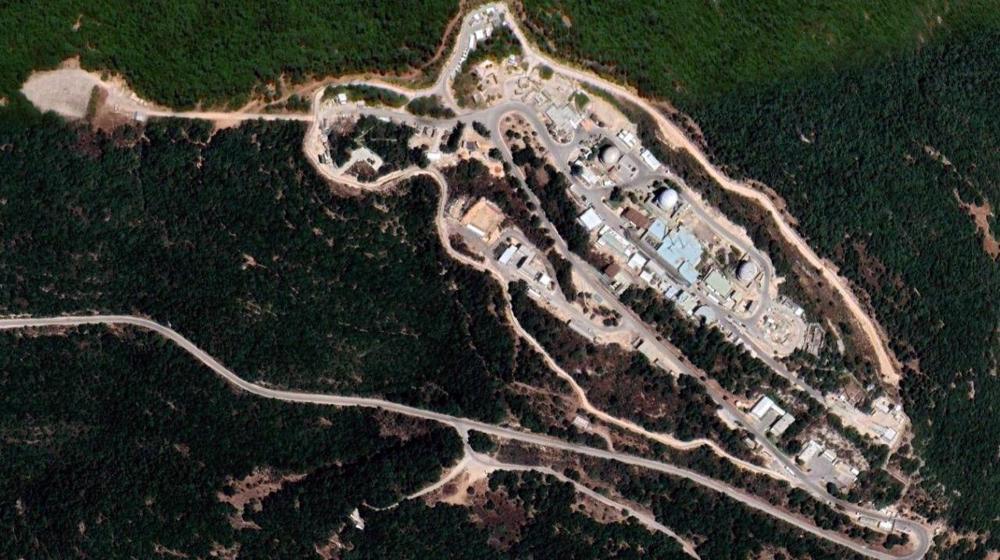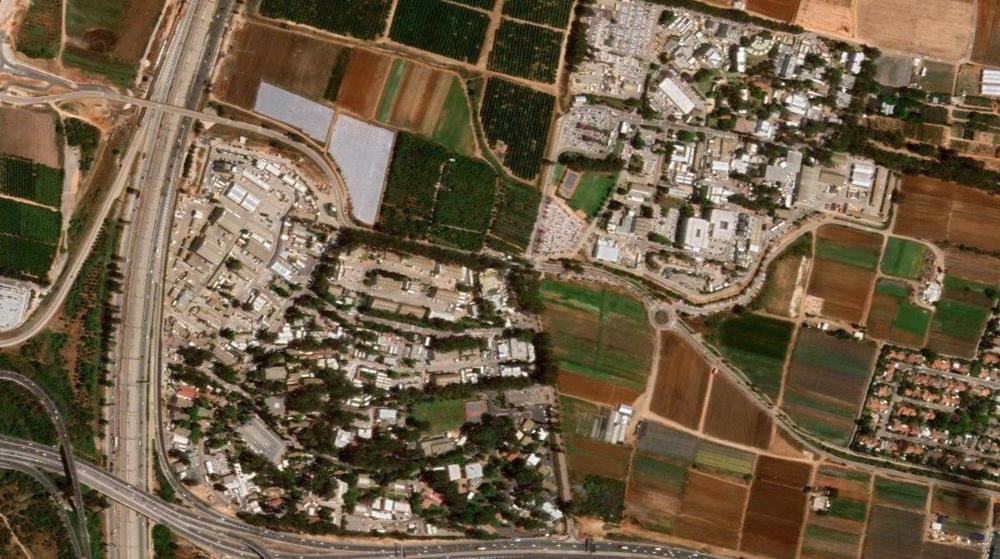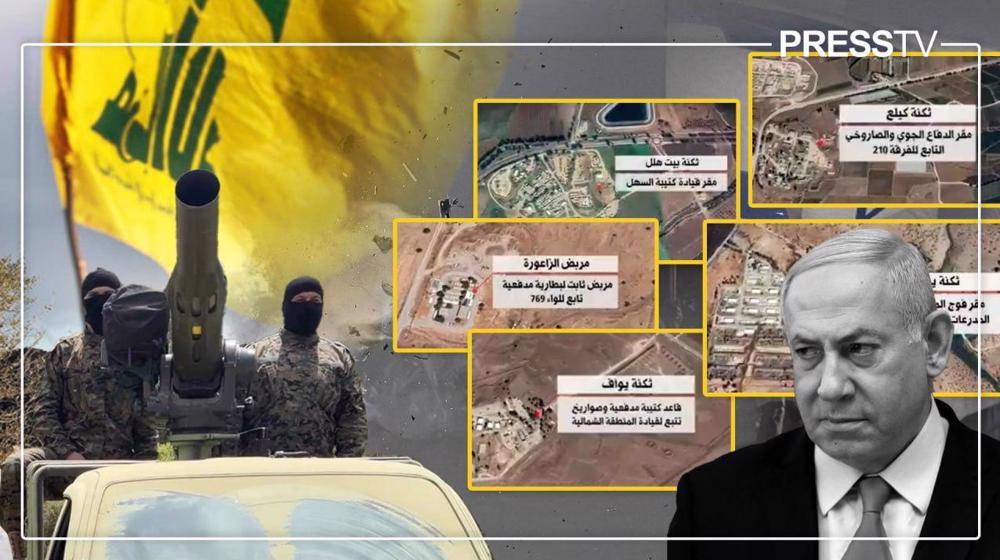Explainer: Which Israeli military sites did Hezbollah target in occupied territories?
By Ivan Kesic
On Sunday, coinciding with Arba’een, the Lebanese resistance movement Hezbollah carried out a large-scale retaliatory military operation against the Israeli regime deep inside the occupied territories.
The operation, referred to as the first phase of retaliation for the assassination of top-ranking Hezbollah commander Fuad Shukr, involved multiple strategic strikes.
According to a statement issued by Hezbollah, the initial phase of the strategic operation deemed a complete success, targeted key Israeli military barracks and sites to facilitate the deployment of attack drones deep within the occupied territories.
The targets included six Israeli military bases, three barracks, and two artillery positions, all struck by over 320 Katyusha rockets, according to the movement.
The first target was the Meron Base, situated on Mount Meron (Jabal al-Jarmaq), the highest peak in the occupied Palestinian territories.
This base, strategically significant, houses air traffic control, radar, surveillance, communication, and jamming facilities, and serves as the primary military command center for aerial warfare and intelligence for the Israeli military on the northern front.
The Meron Base spans 1 km in length and 200 m in width, at an altitude of 1200 m. It is currently undergoing expansion in its western part and is identifiable by three large radomes (radar domes), which house powerful radar antennas.
These antennas, along with advanced cameras, surveillance devices, and topographical positioning systems, provide excellent signal interception and espionage capabilities over large areas of Lebanon and Syria.
The base is also used for electronic warfare, as evidenced during the first week following the Al-Aqsa Storm Operation, when satellite-based location systems were entirely disrupted over southern Lebanon and northern occupied Palestine.
After precise monitoring of jamming signals that interfered with receivers' ability to detect satellite waves, the Meron Base was identified as the source of this interference, likely aimed at preventing the resistance in Lebanon from using precision-strike devices.

The Meron Base has been a frequent target of Hezbollah's retaliatory strikes due to its role in coordinating Israeli air operations and bombing raids on Lebanon and Syria.
In May 2006, after the assassination of Palestinian Islamic Jihad commander Mahmoud al-Majzoub in Sidon, Hezbollah launched a precise rocket barrage against the base. It was targeted again months later, causing substantial damage.
Since the launch of the genocidal war on Gaza in October last year, the base was first targeted in early January, following the assassination of Hamas political bureau member Saleh al-Arouri, with 62 missiles.
It was targeted again in late April, mid-May, and early July with equally lethal rocket salvos, and most recently, two days before the latest mass attack, with an undisclosed number of missiles.
According to Israeli media reports, the damage was repaired after the first strike, and new equipment was installed, which was subsequently targeted in later strikes, leading to compounded damage.
This time, Katyusha rockets were primarily used to overwhelm the Israeli air defense system, while the radome antennas were hit by precision-guided ATGM missiles, with impact footage released by Hezbollah's military media.
In addition to the Meron Base, other targets included artillery positions at Neve Ziv and Zaoura, as well as the Kaila, Yoav, and Ramot Naftali barracks, and the Jaatoun, Sahel, Nafah, Yardena, and Ein Zeitim bases.
In his speech following the operation, Hezbollah Secretary-General Sayyed Hassan Nasrallah explained that these positions were targeted to exhaust the Iron Dome interceptor missiles, paving the way for a successful drone strike deep within the occupied territories.
He noted that while the initial plan was to launch 300 Katyusha rockets, the final count reached 340, emphasizing that no advanced ballistic missiles were used in this phase.

Following the completion of the first phase, the second phase involved a swarm of drone attacks on the Glilot intelligence base between Tel Aviv and Herzliya, and the Ein Shemer Airbase between Hadera and Harish.
These targets, located 110 and 75 km from the Lebanese border respectively, were struck by drones that flew undetected over the Beqaa Valley.
The Glilot Base serves as the operational headquarters for the military intelligence unit 8200, where collected information is processed and forwarded to military strategists and other Israeli intelligence agencies, including Mossad.
As the most critical site of the Israeli military intelligence (Aman), the Glilot Base was previously identified in a Press TV website analysis as a likely target of a retaliatory strike.
The Ein Shemer Airbase, another target, is a crucial air defense site housing Arrow 2 anti-ballistic missile systems and Great Pine Radars with a range of 1,000 km.
China expands use of Iranian rail corridor for cargo transit
Ukraine’s Zelensky says open to dropping NATO bid for security guarantees
Israel kills 3 in south Lebanon as it threatens ‘wide-scale’ attack
VIDEO | Iran’s mega solar plant to power 2.5 million homes
Hamas warns against Israel's plans to 're-engineer' Gaza
VIDEO | South Koreans join migrants in Seoul to protest on Migrant Workers' Day
VIDEO | Press TV's news headlines
VIDEO | Iraq, UN officially mark end of UNAMI mission in country










 This makes it easy to access the Press TV website
This makes it easy to access the Press TV website